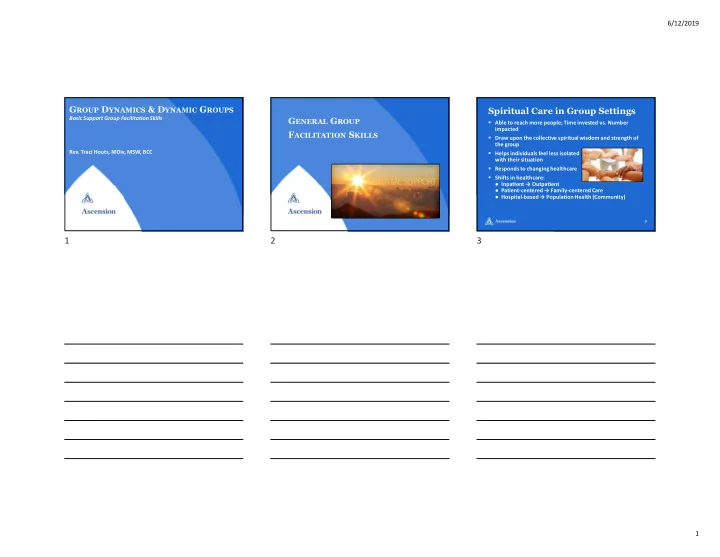

6/12/2019 G ROUP D YNAMICS & D YNAMIC G ROUPS Spiritual Care in Group Settings Basic Support Group Facilitation Skills G ENERAL G ROUP Able to reach more people; Time invested vs. Number impacted F ACILITATION S KILLS Draw upon the collective spiritual wisdom and strength of the group Rev. Traci Houts, MDiv, MSW, BCC Helps individuals feel less isolated with their situation Responds to changing healthcare Shifts in healthcare: ● Inpa(ent → Outpa(ent ● Patient-centered → Family-centered Care ● Hospital-based → Popula(on Health (Community) 3 1 2 3 1
6/12/2019 Formats of Groups: Types of Groups Invitation for further brainstorming: Benefits and Challenges Inpatient: behavioral health, stroke support (rehab) Open vs. Closed Outpatient: pain clinic, behavioral health, neurology clinic What are the unique needs of our population? Our (M.S., myasthenia gravis), cardiac rehab hospital? Our community? Flexibility for busy people Community: grief support, perinatal loss What groups should Spiritual Care be providing ? Driven by individual determining his/her own need Caregiver groups What groups should Spiritual Care be involved in ? Can’t prepare for group dynamics Who can we partner with? Collaboration is key! A group of “groupies” What resources are needed: staffing and materials? Closed can allow for higher degree of trust/vulnerability Help people move to next step; prevent from getting “stuck” 4 5 6 4 5 6 2
6/12/2019 Formats of Groups: Formats of Groups: A Word of Caution: Benefits and Challenges Benefits and Challenges Support group vs. Social group Non-structured Peer Support Spiritual Care to Existing Groups Vs. Curriculum Based Allows for partnership and Group can bond and become “intimidating to newcomers” The power of peer support collaboration The group identifies priorities and needs The needs of the group become more social at some point Lets chaplains practice within their scope and expertise The risk of unsolicited advice by peers How to support those social needs and “launch” a group on Can reach a lot of different types their own Curriculum based: knowledge is power of groups My bias: closed group with curriculum then help support Gives a focus to the group Spreads the work among several transition to greater independence More preparation invested at developing a thoughtful chaplains rather than on-going Identifying natural leaders curriculum commitment of one 6-8 week closed group then once a month then transition Provides a framework that can better support the facilitator For those participants who desire leadership more, can follow-up individually 7 8 9 7 8 9 3
6/12/2019 Getting Started: Best Practices: Best Practices: Referral and Screening through Registration Co-facilitators Keeping Good Boundaries Important to understand motivation of individual Allows for two sets of eyes on group dynamics Set expectations: what we are and what we are not What are they looking to get from a group? Shares the workload Model respect, listening, and caring Must have similar losses/issues Can “play” off each other—Help when you’re stuck Solicit ground rules from the group: attendance, confidentiality, speaking for self, honoring feelings, ability to Are they ready for group? One can stay with group if one needs to follow individual pass, sharing time, no “should’s” Can they make a commitment? Can be two chaplains or one chaplain and another Developing a routine can help provide emotional safety professional It’s o.k. to decline, but then have ● Begin with opening reflection/reading Simply better from a risk management perspective a referral ready ● Use of ritual: lighting a candle, silence, ringing a bell Ideal size for closed group: Make sure that philosophies and styles are not contradictory no fewer than 6; no more than 10 ● Create sacred space but not a prayer group or Bible study Balance among co-facilitators Ideal length of closed group: 6-8 sessions Planning and debriefing each session is important 10 11 12 10 11 12 4
6/12/2019 Best Practices: Boundaries of Facilitators Managing Difficult Personalities Keeping Good Boundaries Over-iden(fying → becoming a group member Introductions for first session of closed group: Therapeutic use of self for the sake of the group process ● Who am I and why I am here? Not a therapist and not a CPE group ● What do I hope to gain from the group? Not developing alliances with any certain member ● What do I feel I can give to the group? While you are a chaplain, this group may not be a The Talker The Hijacker Checking-in spirituality group therefore be careful not to turn everything into a spiritual/religious issue ● For smaller group, each member has given amount of time Become comfortable with silence, tears or anger, not ● Use of timer--feels better than facilitator cutting off knowing “the answers” ● For larger group, have them sign in and “reserve” time for check-in ● Another strategy: ask a check-in question that is focused The Interrupter The Silent One on the topic of the day 13 14 15 13 14 15 5
6/12/2019 Developing Your Skills General Group Facilitation Skills Ask permission to sit in and observe groups Volunteer to co-facilitate with an experienced professional as a mentor Invite stories from colleagues whom you know have run groups Gather resources and build your files 16 17 16 17 6
Recommend
More recommend